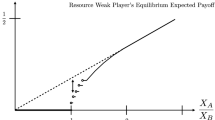Abstract
Consider a symmetric common-value Tullock contest with incomplete information in which the players’ cost of effort is the product of a random variable and a deterministic real function of effort, d. We show that the Arrow–Pratt curvature of d, \(R_{d},\) determines the effect on equilibrium efforts and payoffs of the increased flexibility/reduced commitment that more information introduces into the contest: If \(R_{d}\) is increasing, then effort decreases (increases) with the level of information when the cost of effort (value) is independent of the state of nature. Moreover, if \(R_{d}\) is increasing (decreasing), then the value of public information is nonnegative (nonpositive).
Similar content being viewed by others
References
Baye, M., Hoppe, H.: The strategic equivalence of rent-seeking, innovation, and patent-race games. Games Econ. Behav. 44, 217–226 (2003)
Clark, D., Riis, C.: Contest success functions: an extension. Econ. Theory 11, 201–204 (1998)
Denter, P., Morgan, J., Sisak, D.: Where ignorance is bliss, ’tis folly to be wise: transparency in contests. University of St. Gallen, School of Economics and Political Science Discussion Paper No. 1128 (2011)
Einy, E., Moreno, D., Shitovitz, B.: The value of public information in a Cournot duopoly. Games Econ. Behav. 44, 272–285 (2003)
Einy, E., Haimanko, O., Moreno, D., Sela, A., Shitovitz, B.: Equilibrium existence in Tullock contests with incomplete information. J. Math. Econ. 61, 241–245 (2015)
Jackson, M.: Bayesian implementation. Econometrica 59, 461–477 (1993)
Konrad, K.: Strategy and Dynamics in Contests. Oxford University Press, Oxford (2008)
Kovenock, D., Morath, F., Münster, J.: Information sharing in contests. J. Econ. Manage. Strat. 24, 570–596 (2015)
Morath, F., Münster, J.: Information acquisition in conflicts. Econ. Theory 54, 99–129 (2013)
Myerson, R.B., Warneryd, K.: Population uncertainty in contests. Econ. Theory 27, 469–474 (2006)
Skaperdas, S., Gan, L.: Risk aversion in contests. Econ. J. 105, 951–962 (1995)
Szidarovszky, F., Okuguchi, K.: On the existence and uniqueness of pure Nash equilibrium in rent-seeking games. Games Econ. Behav. 18, 135–140 (1997)
Tullock, G.: Efficient rent-seeking. In: Buchanan, J.M., Tollison, R.D., Tullock, G. (eds.) Toward a Theory of Rent-Seeking Society. Texas AM University Press, College Station (1980)
Vohra, R.: Incomplete information, incentive compatibility and the core. J. Econ. Theory 54, 429–447 (1999)
Warneryd, K.: Information in conflicts. J. Econ. Theory 110, 121–136 (2003)
Wasser, C.: Incomplete information in rent-seeking contests. Econ. Theory 53, 239–268 (2013)
Acknowledgments
We are grateful to Dan Kovenock and referees for helpful comments and suggestions. Einy acknowledges financial support of the Israel Science Foundation, Grant 648/13. Moreno acknowledges financial support from the Ministerio Economía y Competitividad (Spain), Grants ECO2014-55953-P and MDM2014-0431, and from the Comunidad de Madrid, Grant S2015/HUM-3444.
Author information
Authors and Affiliations
Corresponding author
Appendix
Appendix
Lemma 6.1
A symmetric common-value Tullock contest with complete information in which the players’ cost of effort is a twice differentiable strictly increasing and convex function \(c:{\mathbb {R}} _{+}\rightarrow {\mathbb {R}}_{+}\) such that \(c(0)=0\) has a unique pure strategy Nash equilibrium. Moreover, this equilibrium is symmetric and interior.
Proof
In the game associated with a symmetric common-value Tullock contest with complete information the set of pure strategies of every player is \({\mathbb {R}}_{+}\), and the payoff function of each player \(i\in N\) is \(h_{i}:{\mathbb {R}}_{+}^{n}\rightarrow {\mathbb {R}}_{+}\) given for \(x\in {\mathbb {R}}_{+}^{n}\backslash \{0\}\) by
where \(v>0\) is the players’ common value and \(\bar{x}=\sum _{j=1}^{n}x_{j}\), and
where \(\rho \in \Delta ^{n}\) is predetermined. Thus, \(h_{i}\left( \cdot ,x_{-i}\right) \) is twice differentiable and concave on \({\mathbb {R}}_{++}\), and
Let \(x^{*}\in {\mathbb {R}}_{+}^{n}\) be a pure strategy Nash equilibrium. Then, for all \(i\in N\), player i’s effort \(x_{i}^{*}\) solves the problem
i.e., \(\left( \partial h_{i}(x^{*})/\partial x_{i}\right) x_{i}^{*}=0.\) Clearly, \(x^{*}\ne 0;\) since \(n\ge 2,\) then \(\rho _{i}<1\) for some \(i\in N,\) and therefore
for \(\varepsilon >0\) sufficiently small. Let \(k\in N\) be such that \(x_{k}^{*}>0.\) Then,
for all \(i\in N\backslash \{k\}.\) Thus, \(x_{i}^{*}>0\), and therefore \( \partial h_{i}(x^{*})/\partial x_{i}=0,\) i.e.,
for all \(i\in N.\) Hence, \(x_{i}^{*}=t^{*}>0\) for all \(i\in N,\) where \( t^{*}\) is the unique solution (recall that \(c^{\prime \prime }\ge 0)\) to the equation
Obviously, the profile \((t^{*},\ldots ,t^{*}),\) where \(t^{*}\) is the solution to Eq. (9), is a pure strategy equilibrium. Hence, the contest has a unique pure strategy Nash equilibrium, which is symmetric and interior. \(\square \)
Lemma 6.2
Let \(f:{\mathbb {R}}^{2}\rightarrow {\mathbb {R}}\) be twice differentiable and homogeneous of degree one. Then, f is convex (concave) on \({\mathbb {R}}^{2}\) if and only if \(f_{xx}(x,y)\ge 0\) (\(f_{xx}\mathrm{(}x,y\mathrm{)}\le 0\)) for all \((x,y)\in {\mathbb {R}}^{2}.\)
Proof
By Euler’s Theorem,
Differentiating with respect to x on both sides on this equation and simplifying yields
Likewise,
Hence,
and therefore
Thus, the eigenvalues of the Hessian matrix of f are nonnegative (nonpositive) when \(f_{xx}\) is a nonnegative (nonpositive) function on \( {\mathbb {R}}^{2}\). \(\square \)
Rights and permissions
About this article
Cite this article
Einy, E., Moreno, D. & Shitovitz, B. The value of public information in common-value Tullock contests. Econ Theory 63, 925–942 (2017). https://doi.org/10.1007/s00199-016-0974-3
Received:
Accepted:
Published:
Issue Date:
DOI: https://doi.org/10.1007/s00199-016-0974-3




